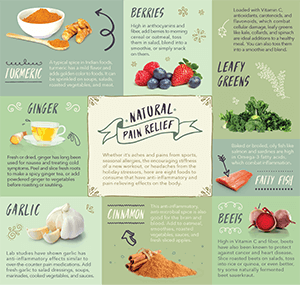If you’re someone who’s constantly on the lookout for natural pain relief options, you might be wondering if certain foods have the power to alleviate discomfort. Well, you’re in luck! In this article, we’ll explore the fascinating world of food and its potential to provide natural pain relief. So, can certain foods really help ease your aches and pains? Let’s find out!
When it comes to pain relief, many people turn to medications or topical creams. But what if there was a more delicious way to find relief? Believe it or not, there are certain foods that possess incredible properties that may help soothe your pain. From anti-inflammatory fruits to spices with analgesic effects, the world of culinary delights is filled with potential remedies. So, if you’re curious about how food can play a role in natural pain relief, keep reading as we dive into the wonderful world of edible remedies. Get ready to tantalize your taste buds while finding relief for your body!
Can Certain Foods Provide Natural Pain Relief?
Pain is something that many people experience on a regular basis, whether it’s from a chronic condition, an injury, or just the wear and tear of everyday life. While there are plenty of over-the-counter and prescription medications available to help manage pain, some people prefer to explore natural alternatives. One potential avenue to explore is the role that certain foods can play in providing natural pain relief. While it’s important to note that food alone is unlikely to completely eliminate severe or chronic pain, incorporating specific foods into your diet may help to alleviate some discomfort and promote overall well-being.
The Anti-Inflammatory Diet
One of the key ways that certain foods can provide natural pain relief is through their anti-inflammatory properties. Inflammation is the body’s natural response to injury or infection, but when it becomes chronic, it can contribute to pain and other health issues. The anti-inflammatory diet is centered around consuming foods that have been shown to reduce inflammation in the body. These foods include fruits and vegetables, whole grains, healthy fats like olive oil and nuts, and lean proteins. By incorporating these foods into your diet, you may be able to reduce inflammation and subsequently experience less pain.
In addition to the general principles of the anti-inflammatory diet, there are specific foods that have been shown to have anti-inflammatory properties. Turmeric, for example, contains a compound called curcumin that has been found to reduce inflammation in the body. Ginger, another common spice, also has anti-inflammatory effects. Berries, particularly blueberries and cherries, are rich in antioxidants that can help fight inflammation. Incorporating these foods into your meals and snacks can be a tasty way to potentially reduce pain and promote overall health.
Omega-3 Fatty Acids
Omega-3 fatty acids are a type of healthy fat that has been shown to have numerous health benefits, including reducing inflammation. These fatty acids are found in fatty fish like salmon, mackerel, and sardines, as well as in walnuts, flaxseeds, and chia seeds. Adding these foods to your diet can help to balance the ratio of omega-3 to omega-6 fatty acids, which is believed to play a role in inflammation and pain management.
In addition to their anti-inflammatory properties, omega-3 fatty acids may also help to reduce pain by supporting the health of the nervous system. The nervous system plays a crucial role in transmitting pain signals throughout the body, and by promoting its health, omega-3s may help to modulate these signals and reduce pain perception. Incorporating foods rich in omega-3s into your diet can not only potentially alleviate pain but also provide other health benefits, such as improved heart health and brain function.
Other Pain-Relieving Foods
While the anti-inflammatory properties of certain foods are one way they can provide natural pain relief, there are other mechanisms at play as well. For example, some foods contain compounds that act as natural pain relievers. Chili peppers, for instance, contain a compound called capsaicin that has been shown to reduce pain by blocking certain pain signals. Similarly, cloves contain a compound called eugenol that has analgesic properties.
In addition to specific foods, certain spices and herbs have also been found to have pain-relieving effects. For example, cinnamon has been shown to have anti-inflammatory and analgesic properties. Garlic, another common kitchen ingredient, has been used for centuries for its potential pain-relieving effects. By incorporating these foods and spices into your meals, you may be able to harness their natural pain-relieving benefits.
Exercise and Nutrition
While focusing on specific foods can certainly play a role in natural pain relief, it’s important to remember that a holistic approach is often most effective. Exercise, for example, has been shown to have numerous benefits when it comes to pain management. Regular physical activity can help to reduce inflammation, improve circulation, and release endorphins, which are natural painkillers produced by the body. Combining a healthy diet with regular exercise can provide a synergistic effect, promoting overall well-being and potentially reducing pain.
In conclusion, while certain foods alone are unlikely to provide complete pain relief, they can play a role in managing discomfort and promoting overall wellness. The anti-inflammatory properties of many foods, as well as the presence of compounds that act as natural pain relievers, make them valuable additions to a pain management plan. By incorporating specific foods and spices into your diet, along with regular exercise, you may be able to experience natural pain relief and improve your overall quality of life. Remember to always consult with a healthcare professional before making any significant changes to your diet or exercise routine.
Key Takeaways
1. Certain foods like ginger and turmeric have anti-inflammatory properties that can help alleviate pain naturally.
2. Including omega-3 fatty acids found in fish can reduce inflammation and relieve pain.
3. Consuming cherries or tart cherry juice may help reduce muscle soreness and joint pain.
4. Foods rich in magnesium, such as spinach and almonds, can help relax muscles and reduce pain.
5. Adding spicy foods like chili peppers to your diet can stimulate the release of endorphins, natural painkillers.
Frequently Asked Questions
What are some foods that can provide natural pain relief?
While there is no magic food that can completely eliminate pain, certain foods have been shown to possess anti-inflammatory properties that can help reduce pain and inflammation in the body. These foods include:
– Turmeric: This vibrant yellow spice contains a compound called curcumin, which has powerful anti-inflammatory effects. Adding turmeric to your meals or consuming it as a supplement may help alleviate pain.
– Ginger: Known for its spicy and aromatic flavor, ginger has been used for centuries to relieve pain. It contains compounds that have anti-inflammatory and analgesic properties, making it a natural pain reliever.
Can omega-3 fatty acids help with pain relief?
Yes, omega-3 fatty acids, found in fatty fish such as salmon, sardines, and mackerel, as well as in walnuts and flaxseeds, have been shown to have anti-inflammatory effects. Chronic inflammation is often associated with pain, so consuming foods rich in omega-3s may help reduce pain levels.
In addition to their anti-inflammatory properties, omega-3 fatty acids are also important for overall health, including heart health and brain function.
Are there any fruits that can help alleviate pain?
Absolutely! Several fruits have been found to possess pain-relieving properties. One such fruit is cherries. They contain compounds called anthocyanins, which have been shown to reduce inflammation and pain. Consuming cherries or drinking cherry juice may provide relief from conditions such as arthritis and gout.
Another fruit worth mentioning is pineapple. It contains an enzyme called bromelain, which has been found to have anti-inflammatory effects. Including pineapple in your diet may help reduce pain associated with conditions like osteoarthritis.
Can spicy foods help with pain relief?
Spicy foods can indeed provide natural pain relief. Capsaicin, the compound responsible for the heat in chili peppers, has been shown to have analgesic properties. It works by blocking pain signals and reducing inflammation. Consuming spicy foods or using capsaicin creams topically may help alleviate pain, particularly in conditions like osteoarthritis and neuropathic pain.
However, it’s important to note that spicy foods may not be suitable for everyone, especially those with digestive issues or sensitive stomachs. It’s always best to listen to your body and consume spicy foods in moderation.
How can incorporating these foods into my diet help with pain relief?
By incorporating anti-inflammatory foods into your diet, you can help reduce chronic inflammation, which is often associated with pain. Including foods like turmeric, ginger, omega-3 fatty acids, cherries, and pineapple can provide you with natural pain relief and potentially improve your overall well-being.
It’s important to remember that while these foods may offer pain relief, they should not replace medical treatment for underlying conditions. If you’re experiencing persistent or severe pain, it’s always best to consult with a healthcare professional for proper diagnosis and treatment.
#066 Anti inflammatory food diet for chronic inflammation, chronic pain and arthritis
Final Thoughts
After exploring the topic of whether certain foods can provide natural pain relief, it is clear that there is some truth to the idea. While food alone may not be a magic cure for all types of pain, there are certainly specific foods that have properties that can help alleviate discomfort. Incorporating these foods into your diet can be a natural and holistic approach to managing pain.
One key aspect to consider is the anti-inflammatory properties of certain foods. Inflammation is often a major contributor to pain, and consuming foods that have anti-inflammatory effects can help reduce discomfort. Turmeric, ginger, and leafy greens like spinach and kale are all examples of foods that have been shown to possess anti-inflammatory properties. By including these ingredients in your meals, you may find some relief from pain.
Additionally, foods rich in omega-3 fatty acids, such as fatty fish like salmon and sardines, can help reduce inflammation and promote overall well-being. These healthy fats have been linked to a variety of health benefits, including a potential reduction in pain symptoms. Incorporating omega-3-rich foods into your diet can be a tasty and beneficial way to support your body’s natural pain management systems.
While it’s important to note that food should not be seen as a replacement for medical treatment, incorporating pain-relieving foods into your diet can be a complementary approach to managing discomfort. By making conscious choices about the foods you consume, you have the opportunity to support your body’s natural healing processes and potentially experience some relief from pain. So, why not give it a try and see if certain foods can provide you with the natural pain relief you’re seeking?



